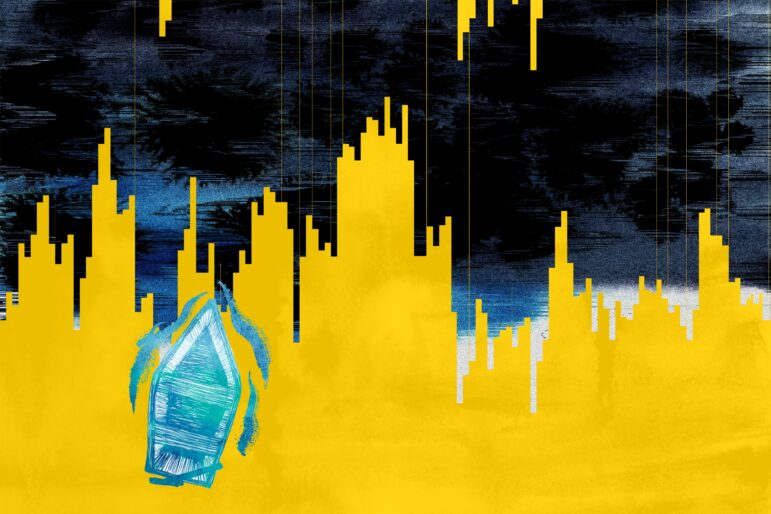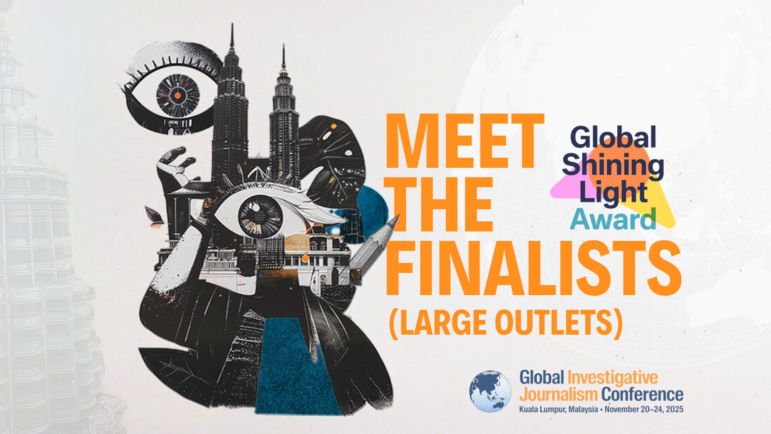

Image: Louiza Karageorgiou
From Flammable Buildings to Slavery’s Hidden Legacy to Tainted Groundwater: Projects from 10 Countries Win GIJN’s 2025 Sigma Awards
Read this article in
As the new hosts of the competition that celebrates the best data journalism from around the world, the Global Investigative Journalism Network is proud to announce the winners of the 2025 Sigma Awards.
Ten outstanding data-driven journalism projects, from as many countries, were chosen by a diverse Prize Committee of 17 judges from 498 entries from 80 countries. The entries comprised 457 single projects and 41 story portfolios. In an encouraging trend, the entries featured more small outlets (with fewer than 35 editorial staff and regular contributors) which were responsible for 238 submissions.
Now settled into its new home at GIJN, the Sigma Awards — uniquely among international awards — continue to feature no subject or format categories, in order to place fewer constraints on potential entries and encourage reporters and editors to submit innovative data-driven projects.
Winning entries included several data stories that exposed the impacts of brutality: the effect of violence against officials on public life in Mexico; the recruitment of prisoners for a mercenary army’s bloodiest battle in Russia’s war on Ukraine; a land trafficking scheme by organized crime syndicates in Ecuador; and the revelation of a 19th-century government betrayal of formerly enslaved people in the United States.
Notably, some of the topics covered and the methodologies used could be replicated in other countries, including the lethal threat of flammable cladding widely used on residential buildings around the world, the climate change-fueled degradation and pollution of freshwater aquifers, and the use of manipulation techniques on messaging app news channels to suppress facts by appealing to emotion and fear.
“Every year, Sigma entries — and Sigma winners — continue to increase in quality and sophistication,” said Gina Chua, a co-founder, with Aron Pilhofer, of the awards. “Our goal for the awards has always been to help spread ideas and techniques among data journalists globally, and it’s heartening to see that vision take root.”
The judging involved two separate tiers, with a shortlist of 50 entries, from 24 countries, initially chosen by a jury of 22 judges. The 10 winners were selected from this list by the Prize Committee in a rigorous deliberation process.
The Sigma Prize Committee was also impressed by the range of data techniques used — from the use of machine learning tools and 3D reconstruction visualizations to the rigorous analysis of hard-to-get records — paired with good storytelling to give meaning and context to those numbers.
Please join us in celebrating — and being inspired by — this year’s winners (listed in alphabetical order).
Project Winners
40 Acres and a Lie — Center for Public Integrity, Reveal, Mother Jones (USA)
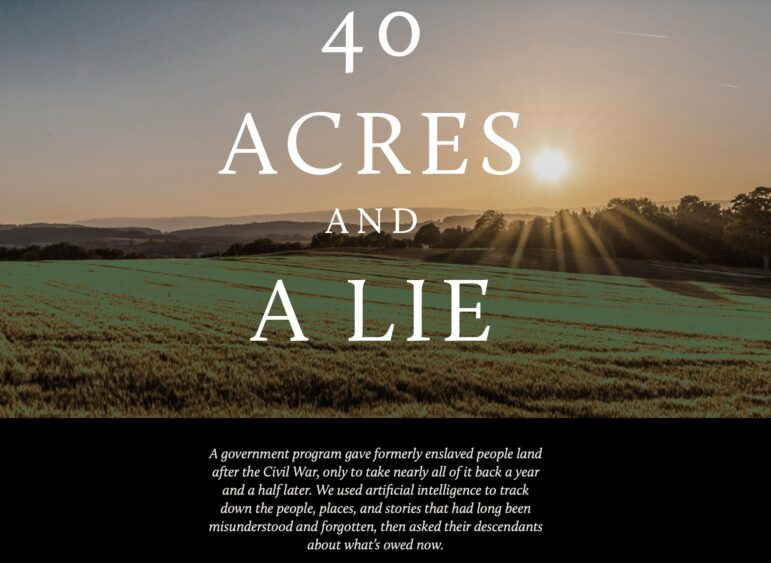
This collaboration uncovered land injustices from more than 150 years earlier in US history, and then traced the impact to living descendants of the original victims. Image: Screenshot, Mother Jones
This powerful series combined data journalism with new genealogy techniques and the sourcing and digitization of 19th-century records to reveal a government betrayal of freed slaves and link their stolen land to living descendants. In a two-and-a-half-year effort, reporters at the Center for Public Integrity identified 1,250 formerly enslaved people who were initially awarded land as a form of reparations — many of whom then saw their land summarily stolen and handed to their former white enslavers. In an astonishing additional step: the project built 100 family trees, and so was able to identify, and notify, 41 living descendants of freed slaves who were awarded land after the US Civil War.
The Prize Committee noted: “This is a phenomenal use of machine learning tools to uncover historically hidden truths and to create a public search repository that can generate hundreds more stories about policies that protect the ancestral rights and resources of a community. It represents the enterprising and resourceful application of technology to historical documents/data to deliver a great public interest journalism project.”
Buildings Wrapped in Solid Gasoline — Reuters (Spain)
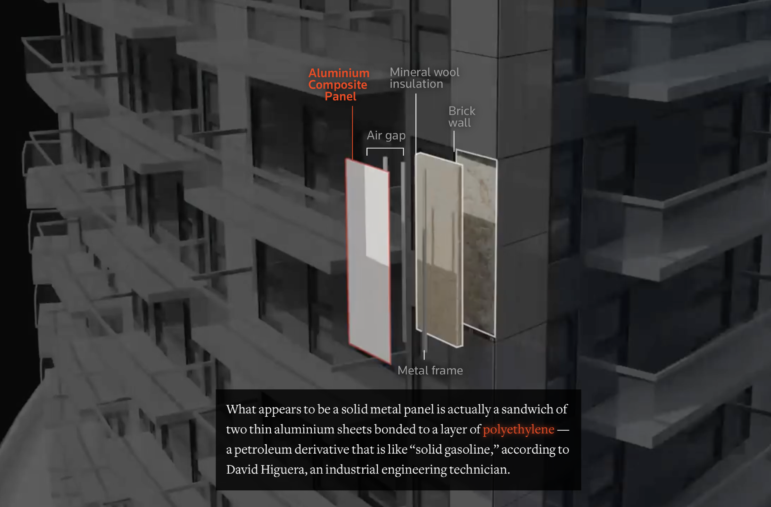
Reuters revealed how the exterior architectural cladding that accelerated the fire on the UK’s Grenfell Tower in 2017 is still in use around the world and fueled a similar high-rise conflagration in Valencia, Spain in 2024. Image: Screenshot, Reuters
This project showed how clear lessons from the 2017 Grenfell Tower fire disaster in London went unlearned for years, with tragic consequences, and still poses a threat to thousands of residential buildings around the world. In a terrific example of the use of data and graphics to explain a highly technical topic, the Reuters team showed how flammable panels fueled a fire that killed 10 people in a high-rise residential building in Valencia, Spain.
The team tracked building materials throughout complex supply and authority chains, examined fire and regulatory reports, and even conducted safety experiments under expert supervision. Notably, the project boosted the story’s impact with innovative scroll-driven video animations and 3D renderings.
The Sigma panel noted: “This investigation takes a deep look at how flammable cladding fueled the deadly high-rise fire in Valencia, exposing ongoing global failures in building safety even years after Grenfell. It stood out for its clear storytelling, strong research, and excellent use of visuals to explain a complex, technical subject. The team turned a difficult fire safety issue into an engaging and accessible investigation with real-world impact. It is an excellent example of data-driven journalism, meeting all the field standards.”
Carousel of Emotions — Texty (Ukraine)

Texty examined the rate of emotional manipulation in posts on the top 100 Telegram channels in Ukraine and found more than two dozen of them pushed false information or loaded language a vast majority of the time. Image: Screenshot, Texty.org.ua
While most prior investigations into the Telegram messaging app in Ukraine have focused on Russian propaganda or fake content, this innovative, six-month project sought to find the extent to which the country’s most popular Telegram channels employ a much broader set of manipulation techniques. As the story notes: “We analyzed the structure of the language and determined the techniques that make the text more emotional, thus diverting attention from facts and evidence.”
The Sigma panel noted: “The judges greatly appreciate the team’s focus on manipulative techniques in modern media, which while being an important source of information in Ukraine and other countries, often fall short of newsroom quality and ethical standards — and commend their success in presenting an academically rigorous project in an accessible, unbiased, and neutral manner.”
Examining the top 100 channels — representing the primary source of news for most Ukrainians — Texty found that the manipulation rate for content on three of them was a stunning 96% or higher, and between 2% and 91% on the rest. The use of “loaded language,” appeals to fear, and sowing doubt were among the 10 manipulation techniques the team carefully mapped out in the piece.
The citation added: “From a nerdish perspective, judges commend the choice of an open source model and the clear explanation of why task-specific fine-tuning is necessary, rather than relying on models ‘out of the box.’ Overall, this is brilliant work and truly inspiring!”
Terranexus Durán: Las conexiones detrás del tráfico de tierras en la bodega de la droga de Ecuador (Terranexus Durán: The Connections behind Land Trafficking in Ecuador’s Drug Warehouse) — Unidad de Investigación Tierra de Nadie, CONNECTAS (Ecuador)
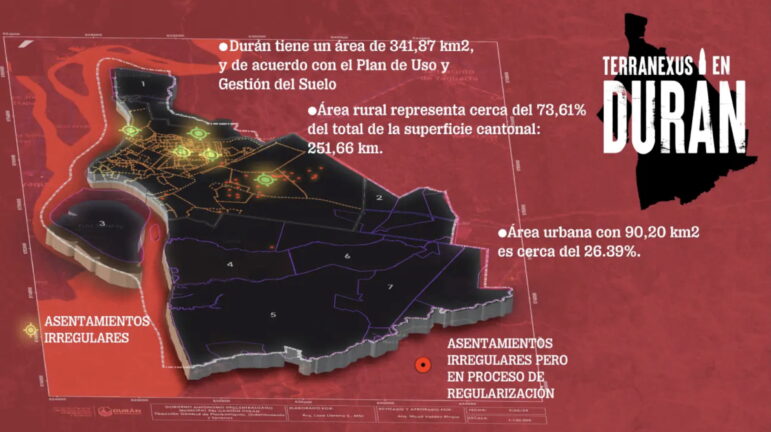
This project exposed how often coercive techniques were being used by drug traffickers and their proxies to take over public and private land in the Ecuadorian coastal city of Durán. Image: Screenshot, Investigación Duran
This project employed courageous reporting and solid data journalism techniques to expose a hidden land trafficking scheme that has given criminal gangs control of large portions of Ecuador’s coastal city of Durán. Operating in an “information desert” beset with media obstruction, criminal intimidation, and falsified official documents, Tierra de Nadie and CONNECTAS were able to show how gangs colluded with municipal officials through a combination of coercion and corruption to appropriate vacant land, seize private homes, and take control of key urban areas on drug export routes. In addition to numerous interviews, the team used mapping and data analysis techniques to illuminate transactions garnered from land registry records and other government documents.
According to the Sigma citation: “Terranexus Durán is a brilliant example of data journalism strategies successfully applied to a very dangerous and extremely necessary story. The reporters managed to document and expose how criminals are buying, piece by piece, the land beneath the feet of the Ecuadorians living in the coastal city of Durán. This is a local story that should be replicated all over the world where the housing crisis, violence, and unrest are on the rise because of the accumulation of land and all classes of property by organized criminal groups.”
The Price of Bakhmut — Mediazona, BBC News Russian (Russia)
In a great example of document sourcing and investigative data analysis, Mediazona and BBC News Russian exposed the grim secret behind the bloodiest battle of Russia’s war on Ukraine. Relying on data sources that included death payment documents to families of fallen soldiers, the team was able to show how Yevgeny Prigozhin’s Wagner organization recruited an army of prison inmates for reckless assaults in the 20-month battle of Bakhmut that lasted from January 2022 to August 2023. The project also had to carefully protect the identity of certain sources and team members, given draconian laws against dissent and war leaks inside Russia.
“The Price of Bakhmut revealed how Wagner’s mercenary army recruited thousands of prisoners and sent them to their deaths in brutal ‘meat assaults,’” wrote one Sigma judge. “Using data including payments to bereaved families, chat room discussions, lawsuits, and dog tags, the journalists showed in detail the insidious recruitment system and the lethal exploitation of ‘free’ recruits. Stunning and inspirational work.”
In addition to website audiences in the tens of thousands, the piece also attracted the attention of more than a million viewers on YouTube.
Under the Surface — Le Monde, Datadista, De Staandard, Facta, Dagbladet Information, Reporters United, Arena for Journalism in Europe, Journalismfund Europe (France)
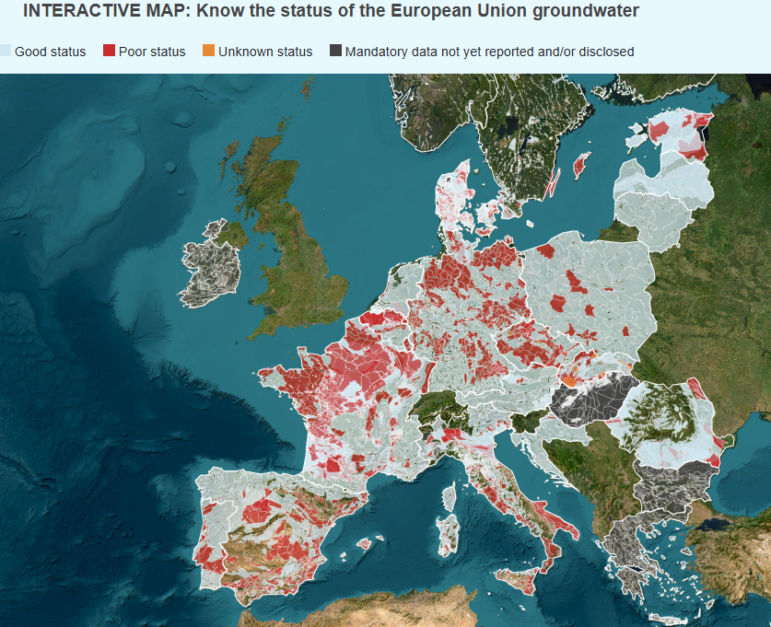
A transnational cooperative investigation exposed how pollution and climate change are threatening an increasing share of Europe’s groundwater reservoirs. Image: Screenshot, Le Monde
In an important environmental data-driven investigation that could be replicated on other continents, this cross-border project exposed a hidden, climate change-fueled crisis in the groundwater system that sustains Europe. Fourteen journalists from seven partner outlets analyzed a vast trove of records to find that the continent’s fresh water aquifers are depleting, and that “what remains is facing near-irreversible pollution.” The investigation found that 26% of the region’s aquifers, by surface area, are already in “poor condition,” due to industrial overexploitation, climate change, and exposure to a large number of banned pesticides and micropollutants. Importantly, the project also successfully tied the threats and impacts to individual farmers, exporters, and village residents.
The Sigma panel wrote: “The investigation found that substances banned decades ago persist in the water table. With sophisticated data analysis techniques, this investigation risked becoming a dry recitation of the results. But the news organizations found ways to keep it engaging and interactive. It led readers through the details of each pollutant without overwhelming them with detail that might detract from the storytelling.”
The project also featured a slew of advanced data techniques, including the use of the Python language to extract micropollutant analyses, interactive map graphics with MaplibreGL JS library and OpenStreetMap, and scrollytelling features using an in-house tool.
The jury added: “Judges praised the dynamic visuals, the in-depth analysis, and the clear methodology that could be replicated elsewhere.”
Votar entre Balas (Vote Between the Bullets) — Data Cívica, Animal Político, México Evalúa (Mexico)
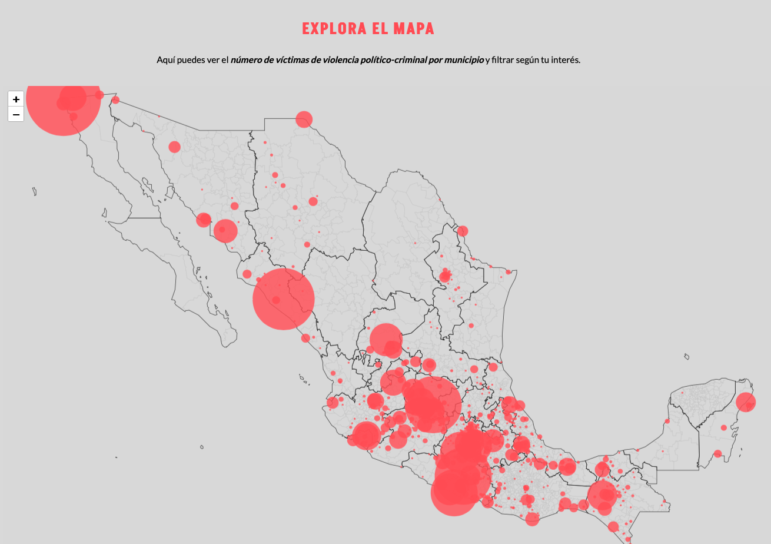
In this investigation, three Mexican news outlets worked together to create a one-of-a-kind dataset to map the extent of political-criminal violence across the country. Image: Screenshot, DataCivica
This courageous project showed how organized attacks against public figures influence public life in Mexico, and involved both the painstaking construction of a database on political-criminal violence and the use of accessible interactive maps and data visualizations to vividly show their impact. Delving into a deep-rooted problem in Mexico with very little reliable official data, Data Cívica and its research collaborators built a tool that automated the search for news accounts of political-criminal violence, and provided open access to the curated data on a single platform. The entrants noted that this includes the only systematic database on the issue that exists in Mexico, and that it remains fully public and free.
The Sigma panel noted: “Votar entre Balas investigates how Mexico’s elections became a battlefield for organized crime, where violence dictated who could participate in democracy. Data, maps, and testimonies reveal a chilling strategy to control local power through fear.”
Portfolio Winners
Last Story — (Gaza and West Bank)
Entry 1, Entry 2, Entry 3, Entry 4
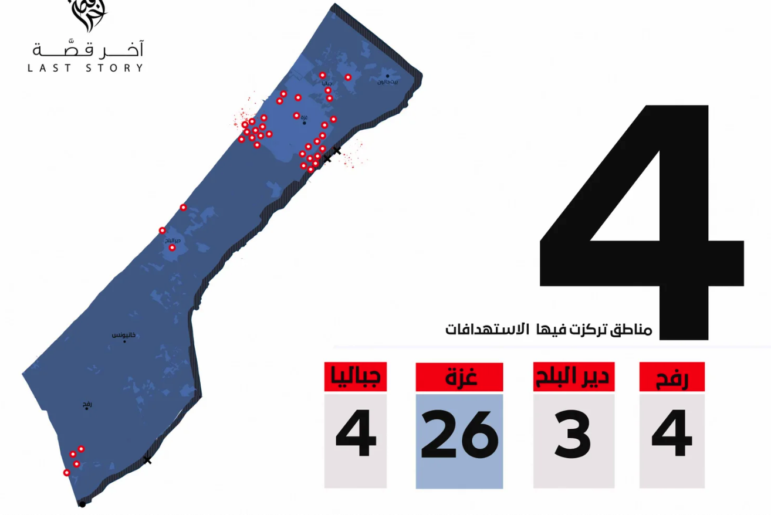
Last Story documented 37 attacks on relief aid centers across four different population centers in Gaza from October 2023 through March 2024. Image: Screenshot, Last Story
This diverse set of projects from Last Story, grounded in solid data sources, were produced in both physically perilous and logistically difficult conditions, with a frequent lack of internet access and electricity added to the dire security threat in Gaza. And while most other media in the area focused on military accountability and the aid crisis, these projects examined specific health and economic impacts of the war on vulnerable individuals and groups. Data analysis, clear charts, and powerful human stories were combined for issues such as the changing number of working dialysis machines and kidney failure patients; soaring rates of extreme poverty among the elderly; and increased rates of child labor and malnutrition.
The Sigma citation stated: “Last Story speaks straight to the heart, and being able to raise awareness is a quality that needs to be valued in data-driven journalism. The production is well made by a courageous team from within one of the most conflict-ridden places on Earth, the Gaza Strip. This ability of speaking from inside the territory is what breathes life into the [stories].
The work is technically excellent. Each story is unique, but there’s a visual identity that unites them. The attention to aesthetics stands out, coupled with data and reports, a combination that creates very impactful results. Last Story has an eye for choosing stories that have aspects less approached by other media outlets.”
Salud Con Lupa — (Peru)
Entry 1, Entry 2, Entry 3, Entry 4, Entry 5

Among the data investigations Salud con Lupa submitted in its award-winning entry was this detailed look at the widespread shortages of the drug insulin in both public and private pharmacies across Peru. Image: Screenshot, Salud con Lupa
In a remarkable output of high-quality investigations for a small team, Peru’s Salud con lupa produced several important public interest investigations that combined advanced data techniques with dogged document sourcing and traditional field reporting. Submitted entries included stories on sanctions evasion, child pregnancy, and regulatory failures that allow the widespread use of dangerous pesticides.
“This portfolio showcases investigations grounded in rigorous data analysis, public information requests, and in-depth field reporting, revealing key facts and amplifying the voices of those affected,” the Sigma judges noted. “Some stories also influenced public policy or incorporated an international benchmarking perspective. Salud con lupa stands as a leading example of high-quality, meaningful data-driven journalism from a small newsroom in Peru, shedding light on urgent public health issues.”
SCMP Graphics — South China Morning Post (Hong Kong)
Entry 1, Entry 2, Entry 3, Entry 4
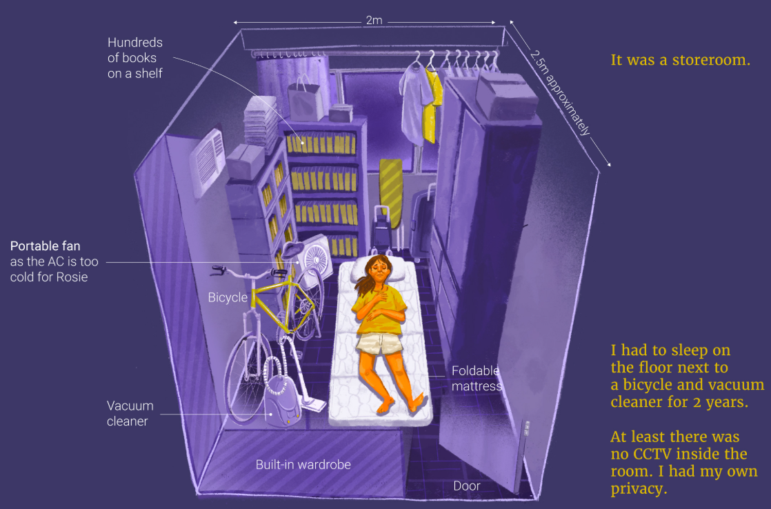
As part of its portfolio entry, the South China Morning Post presented data visualizations that detailed the dire living conditions of Hong Kong’s many foreign domestic workers. Image: Screenshot, SCMP
Good graphics have the power to clearly explain nuanced issues virtually at a glance, and the nine-member graphics team at the South China Morning Post has consistently produced visualizations that exemplify good data journalism, from illegal buildings to the lethal hazards of trench warfare in Ukraine. Their illustrations of the living conditions faced by many of Hong Kong’s 350,000 foreign domestic workers — including sleeping in cluttered storage rooms smaller than most prison cells — offer an inspiring model of explanatory journalism that words or numbers can’t match.
The Sigma Prize Committee wrote: “The SCMP Graphics Team produced a remarkable series of visual stories; from the hidden lives of domestic helpers to illegal construction mapping and major global events; turning complex public issues into vivid, human-centered narratives.
We were especially impressed by how this work blends creativity, data, and storytelling into a seamless experience. The team’s ability to transform complex topics into powerful, beautifully crafted narratives is a perfect example of what great data-driven journalism can achieve.”
 Rowan Philp is GIJN’s global reporter and impact editor. He was formerly chief reporter for South Africa’s Sunday Times. As a foreign correspondent, he has reported on news, politics, corruption, and conflict from more than two dozen countries around the world.
Rowan Philp is GIJN’s global reporter and impact editor. He was formerly chief reporter for South Africa’s Sunday Times. As a foreign correspondent, he has reported on news, politics, corruption, and conflict from more than two dozen countries around the world.

